Unit - 1
Multivariable Integral Calculus
Double integral –
Before studying about multiple integrals, first let’s go through the definition of definition of definite integrals for function of single variable.
As we know, the integral

Where is belongs to the limit a ≤ x ≤ b
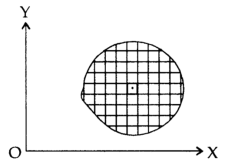
This integral can be written as follows-

Now suppose we have a function f (x, y) of two variables x and y in two-dimensional finite region Rin xy-plane.
Then the double integration over region R can be evaluated by two successive integrations

Evaluation of double integrals-
If A is described as 
Then,
 ]dx
]dx
Let do some examples to understand more about double integration-
Example-1: Evaluate  , where dA is the small area in xy-plane.
, where dA is the small area in xy-plane.
Sol. Let, I = 
= 
= 
= 
= 84 sq. Unit.
Which is the required area.
Example-2: Evaluate 
Sol. Let us suppose the integral is I,
I = 
Put c = 1 – x in I, we get
I = 
Suppose, y = ct
Then dy = c
Now we get,
I = 
I = 
I = 
I = 
I =
As we know that by beta function,

Which gives,



Now put the value of c, we get

= π/2 [ ¾ (1) – 3/7 (1) – ¾ (-1) + 3/7 (-1)] = π/2 [9/14] = 9π/28
Example-3: Evaluate the following double integral,

Sol. Let,
I = 
On solving the integral, we get



= 5π/8
Double integration in polar coordination
In polar coordinates, we need to evaluate

Over the region bounded by θ1 and θ2.
And the curves r1(θ) and r2(θ)
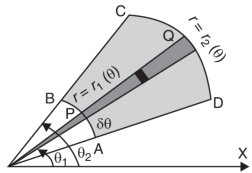
Example-1: Evaluate the following by changing to polar coordinates,

Sol. In this problem, the limits for y are 0 to  and the limits for are 0 to 2.
and the limits for are 0 to 2.
Suppose,
y = 
Squaring both sides,
y² = 2x - x²
x² + y² = 2x
But in polar coordinates,
We have,
r² = 2r cos θ
r = 2 cos θ
From the region of integration, r lies from 0 to 2 cos θ and θ varies from 0 to π / 2.
As we know in case of polar coordinates,
Replace x by r cos θ and y by r sin θ, dy dx by r dr dθ,
We get,


Example-2: Evaluate the following integral by converting into polar coordinates.

Sol. Here limits of y,
y = 
y² = 2x - x²
x² + y² = 2x
x² + y² - 2x = 0 ……………… (1)
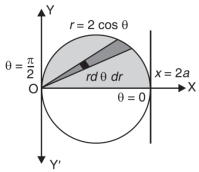
Eq. (1) represent a circle whose radius is 1 and centre is (1, 0)
Lower limit of y is zero.
Region of integration in upper half circle,
First, we will convert into polar coordinates,
By putting
x by r cos θ and y by r sin θ, dy dx by r dr dθ,
Limits of r are0 to 2 cos θ and limits of θ are from 0 to π / 2.



Example-3: Evaluate 
Sol. Let the integral,
I = 
=




Put x = sin θ


= π / 24 ans.
Triple integrals
Definition: Let f (x, y, z) be a function which is continuous at every point of the finite region (Volume V) of three-dimensional space. Divide the region V into n sub regions of respective volumes . Let (
. Let ( ) be a point in the
) be a point in the  sub region then the sum:
sub region then the sum:

Is called triple integration of f (x, y, z) over the region V provided limit on R.H.S of above Equation exists.
Spherical Polar Coordinates
1) For the spheres x2 + y2 + z2 = r2
Put x = r sin θ cos x, y = r sin θ sin , z = r cos θ
Dx dy dz = r2 sin θ dr dθ d
(a) For complete sphere x2 + y2 + z2 = a2, θ = 0 to π, = 0 to 2π, r = 0 to a.
(b) For hemisphere x2 + y2 + z2 = a2 , z > 0, θ = 0 to π/2, = 0 to 2π, r = 0 to a
(c) For positive octant of a sphere x2 + y2 + z2 = a2, θ = 0 to π/2, r = 0 to a
2) For ellipsoid x2/a2 + y2/b2 + z2/c2 = 1
Put x = ar sin θ cos , y = b r sin θ sin , z = c r sin θ
Dx dy dz = abc r2 dr dθ d, θ = 0 to π, = 0 to 2π, r = 0 to 1
Dirichlets Theorem: -


Where the integral is extended to all positive values of the variables subjected to the condition 
Ex.1: Evaluate

Solution: Let
I = 
= 
(Assuming m =  )
)
=  dxdy
dxdy
= 
=
=  dx
dx
=  dx
dx
= 
=
I =
Ex.2: Evaluate  Where V is annulus between the spheres
Where V is annulus between the spheres 
And (
( )
)
Solution: It is convenient to transform the triple integral into spherical polar co-ordinate by putting
 ,
,  ,
, 
 , dxdydz=
, dxdydz= sin
sin drd
drd d
d ,
,
 and
and

For the positive octant, r varies from r =b to r =a,  varies from
varies from 
And varies from
varies from 
I= 
= 8
=8
=8
=8
=8 log
= 8 log
I= 8 log I = 4 log
I = 4 log
Ex.3: Evaluate 
Solution: -








= 1/18 [e12 – 2e6 – 9e4 + 18e2 – 8]
Ex.4: Evaluate
 , taken through out the volume of the sphere x2 + y2 + z2 = 1 in positive octant.
, taken through out the volume of the sphere x2 + y2 + z2 = 1 in positive octant.
Solution:
Put x = r sin θ sin , z = r cos θ, dx dy dz = r2 sin θ dr dθ d
θ = 0 to π/2, r= 0 to 1 and x2 + y2 + z2 = r2 φ = 0 to π/2




Where I1 =  put r = sin t
put r = sin t
Dr = cos dt r 0 1
t 0 π/2




= π/4 . ()π/20
= π/4 . π/2
= π2/8
NOTES:
The volume of solid is given by
Volume =
In Spherical polar system

In cylindrical polar system

Ex.1: Find Volume of the tetrahedron bounded by the co-ordinate’s planes and the plane

Solution: Volume = ………. (1)
………. (1)
Put  ,
, 

From equation (1) we have
V = 
=24
=24 (u+v+w=1) By Dirichlet’s theorem.
(u+v+w=1) By Dirichlet’s theorem.
=24 
= =
= = 4
= 4
Volume =4
Ex.2: Find volume common to the cylinders ,
, .
.
Solution: For given cylinders,
 ,
,  .
.
Z varies from
Z=- to z =
to z = 
Y varies from
y= - to y =
to y = 
x varies from x= -a to x = a
By symmetry,
Required volume= 8 (volume in the first octant)
=8 
=8
= 8 dx
dx
=8
=8
=8
Volume = 16
Ex.3: Evaluate

Solution
Put x = r sin θ cos , y = r sin θ sin , z = r cos θ
θ = 0 to π, = 0 to 2π, r = 0 to 1, dx dy dz = r2 sin θ dr dθ d
I = 

= 





= 4a7π / 35
Ex.4:
Integrate  through out the volume bounded x = 0, y=0, z = 0, x/a + y/b+z/c = 1.
through out the volume bounded x = 0, y=0, z = 0, x/a + y/b+z/c = 1.
Solution: x = au dx = a du
y = bv dy = b dv
z = cw dz = c dw
I = 
= 
= a3 b2 c2 
= a3b2c2 
= a3b2c2 
= a3b2c2 2!/7!
= a3b2c2/2520
Ex.5:
Evaluate  throught the volume of the ellipsoid
throught the volume of the ellipsoid 
Solution: Put
x = ar sin θ cos
y = br sin θ sin
z = cr cos θ
Dxdydz = abc r2 drdθd
θ = 0 to π, = 0 to 2π, r = 0 to 1
I = 
= abc 
Put r = sin t dr = cos t dt
If r = 0 then t = 0 and r = 1 then t = π/2
Abc 
= abc 
= abcπ/16 
= abcπ/16 
= abcπ/8 
= abcπ2/4
Example 1: Evaluate

By changing the order of integration.
Solution: The given limits are (inner) y from x to π/2; (Outer) x from 0 to π/2.
We use these to sketch the region of integration.
The given limits have inner variable y. To reverse the order of integration we use horizontal stripes. The limits in this order are
(inner) x from 0 to y; (outer) y from 0 to π/2.
So the integral becomes

We compute the inner, then the outer integrals.
Inner:  Outer : - cos
Outer : - cos  =1
=1
Change of Order of Integration:

This is the case where limits are constants. But if they are variables, then by changing the order of integration, the limits of integration also changes.
A rough sketch helps in fixing the new limits of integration.
Example 1: Change the order of integration in 
Of hence evaluate the same.
Solution:
y = x2 & y = 2 - x
Pt. Of interaction:
x2 + x + 2 = 0
x = 1, 2
y = 1
(1, 1) is coordinate for A
Region of interaction is divided into 2 parts OAM and MAB
For region OAM:
0 ≤ y ≤ 1, 0 ≤ x ≤ y
For region MAB:
1 ≤ y ≤ 2, 0 ≤ x ≤ 2 –y






Example 2: Change the order of integration of evaluate

Solution:
y = x2/4a & y = 2ax
x2 = 4ay & y2 = 4ax
Pt. Of intersection
x4/16a2 = 4ax
x4 – 64 a3x3 = 0
x = 0, 4a
pts, are (0, 0), (4a, 4a)







Determine the image of a region under a given transformation of variables.
Compute the Jacobian of a given transformation.
Evaluate a double integral using a change of variables.
Evaluate a triple integral using a change of variables.
Example 1:
Evaluate  .dA
.dA
Solution:
Here’s is the region bounded by the lines on the real lines
X+ y=0; x+ y=-1
x- y=0 ; x-y = 8
Let
u=x+ y , 0 u 1
v=x-y, 0 v 8
Now we have two choices
*solve for x and y if possible
*use the inverse transmission
Solving for x and y
[ u = x+y] + [ v = x – y] = u + v = 2x
[ u = x+y ] – [ v = x – y] = u – v = 2y
X=1/2(u)+1/2(v) and y =1/2(u-1/2(v)
Using of inverse method:
 and J(x, y) . J(u, v) = 1
and J(x, y) . J(u, v) = 1
J(u, v) = 1/J(u, v)
J(u, v) = 
J(u, v) = (- ¼ ) – ( ¼ ) = - ½


½ (e – 1) 
J(u, v) = 6(e – 1)
Example 2:
Evaluate  .dA
.dA
Solution:
Here s is the region bounded by the lines on the real lines
X - 2y=0; x - 2y= 4
3x-y=1 ;3 x-y = 8
Let
u=x – 2y
v= 3x- y
Now we have two choices
*solve for x and y if possible
*use the inverse transmission
Using of inverse method:
 and J(x, y) . J(u, v) = 1
and J(x, y) . J(u, v) = 1
J(u, v) = 1/J(u, v)
J(u, v) = 
where u/x = 1, u/y = - 2, v/x = 3, v/x = - 1
J(x, y) = 
J(u, v) = 1/J(x, y) J(u, v) = 1/5
Example 3:
Given a plane z= 3x+4y+2 that lies above the rectangle [0,5] [1,4]. Find the surface area
Solution:
The area of the surface with equation z=f(x,y),(x,y)∈ D ,where fx and fy are continuous,
Is A(S)= dA
dA
We have z=2+3x+4y.
Then, z/x = 3 and z/y = 4
A(S) =  dA
dA
From the dimensions of the rectangle, we get the limits of x as (0,5) and the limits of y as(1,4)
On substituting the known values in the expression for area ,we get
A(S) = 
Evaluate the iterated integral.
A(S) =
= 
=15 26
Example 4:
As an example, let us consider the following integral in two dimensions:
I= 
Solution: Where C is a straight line from the origin to (1,1), as shown the figure, Let s be the arc length measured from the origin. We then have
x =s cos θ = s/2
y=s sin θ = s/2
The endpoint (1,1) corresponds to s=2.Thus , the line integral becomes

Definition: evaluating triple integrals is similar to evaluating nested functions: you work from inside out. Triple integrals look scary, but if you take them step by step, they’re no kore difficult than regular integrals. You start in the centre and work your way out. For example, begin by separating two inner integrals.
Example 1: Evaluate the following:

Solution: 



Example 2: Evaluate the following:

Solution: let I = 


Example 3: Evaluate the following triple integral

Solution: let 




Area of double integration
Area in Cartesian coordinates-
Example-1: Find the area enclosed by two curves using double integration.
y = 2 – x and y² = 2 (2 – x)
Sol. Let,
y = 2 – x ………………. (1)
And y² = 2 (2 – x) ………………. (2)
On solving eq. (1) and (2)
We get the intersection points (2,0) and (0,2),
We know that,
Area = 
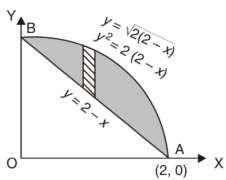
Here we will find the area as below,
Area = 
= 
= 
= 
Which gives,
= (- 4 + 4 /2) + 8 / 3 = 2 / 3.
Example-2: Find the area between the parabola y ² = 4ax and another parabola x² = 4ay.
Sol. Let,
y² = 4ax ………………. (1)
And
x² = 4ay…………………. (2)
Then if we solve these equations, we get the values of points where these two curves intersect

x varies from y²/4a to  and y varies from o to 4a,
and y varies from o to 4a,
Now using the concept of double integral,
Area = 
= 
= 
Area in polar coordinates-
Example-3: Find the area lying inside the cardioid r = a(1+cosθ) and outside the circle r = a, by using double integration.
Sol. We have,
r = a(1+cosθ) ……………………. (1)
And
r = a ………………………………. (2)
On solving these equations by eliminating r, we get
a(1+cosθ) = a
(1+cosθ) = 1
Cosθ = 0
Here a θ varies from – π/2 to π/2
Limit of r will be a and 1+cosθ)
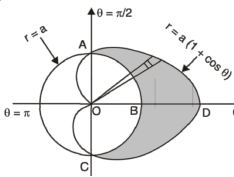




Which is the required area.
Example-4: Find the are lying inside a cardioid r = 1 + cosθ and outside the parabola r (1 + cosθ) = 1.
Sol. Let,
r = 1 + cosθ ……………………. (1)
r (1 + cosθ) = 1……………………. (2)
Solving these equations, we get
(1 + cosθ) (1 + cosθ) = 1
(1 + cosθ) ² = 1
1 + cosθ = 1
Cosθ = 0
θ = ±π / 2
So that, limits of r are,
1 + cosθ and 1 / 1 + cosθ
The area can be founded as below,
= 
= ½ 
= 
= 
= 
= 
= [ θ + θ/2 + sin 2θ/4 + 2 sin θ – ¼ (2 tan θ/2 + 2/3 tan3 θ/2)]π/20
= [π/2 + π/4 +0+ 2 sin π/2 – ½ tan π/4 – 1/6 tan3 π/4] = [3π/4 + 2 – ½ - 1/6 ] = [3π/4 + 4/3]
Double integrals as volumes
Suppose we have a curve y = f(x) is revolved about an axis, then a solid is generated, now we need to find out the volume of the solid generated,
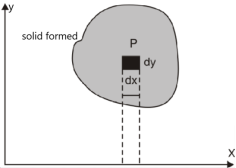
The formula for volume of the solid generated about x-axis,

Example-1: Calculate the volume generated by the revolution of a cardioid,
r = a (1 – cosθ) about its axis
Sol. Here, r = a (1 – cosθ)
Volume =



=
= 2πa3/3 
Which is the volume of generated by cardioid.
Example-2: Find the volume generated by revolving a circle x ² + y² = 4 about the line x= 3.
Sol. We know that,
Volume = 
Here , PQ = 3 – x,
= 
= 2π 

= 2π  (3y – xy)+4-x2-4-x2
(3y – xy)+4-x2-4-x2
= 2π  [34-x2 - x4-x2 + 34-x2 - x4-x2]
[34-x2 - x4-x2 + 34-x2 - x4-x2]
= 4π[3 4 – x2 - x4 – x2] dx = 4π [ 3 x/2 4-x2 + 3 4/2 sin-1 x/2 + 1/3(4 – x2)3/2]2-2
= 4π[ 6 π/2+ 6π/2] = 24π2
The volume is 24π².
Example-3: Calculate the volume under the surface z = 3 + x² - 2y over the region R defined as 0≤ x ≤ 1 and -x ≤ y ≤ x
Sol. The is a double integral of z = 3 + x² - 2y over the region R
Volume will be,




References:
- E. Kreyszig, “Advanced Engineering Mathematics”, John Wiley & Sons, 2006.
- P. G. Hoel, S. C. Port And C. J. Stone, “Introduction To Probability Theory”, Universal Book Stall, 2003.
- S. Ross, “A First Course in Probability”, Pearson Education India, 2002.
- W. Feller, “An Introduction To Probability Theory and Its Applications”, Vol. 1, Wiley, 1968.
- N.P. Bali and M. Goyal, “A Text Book of Engineering Mathematics”, Laxmi Publications, 2010.
Unit - 1
Multivariable Integral Calculus
Double integral –
Before studying about multiple integrals, first let’s go through the definition of definition of definite integrals for function of single variable.
As we know, the integral

Where is belongs to the limit a ≤ x ≤ b
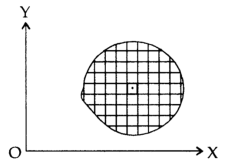
This integral can be written as follows-

Now suppose we have a function f (x, y) of two variables x and y in two-dimensional finite region Rin xy-plane.
Then the double integration over region R can be evaluated by two successive integrations

Evaluation of double integrals-
If A is described as 
Then,
 ]dx
]dx
Let do some examples to understand more about double integration-
Example-1: Evaluate  , where dA is the small area in xy-plane.
, where dA is the small area in xy-plane.
Sol. Let, I = 
= 
= 
= 
= 84 sq. Unit.
Which is the required area.
Example-2: Evaluate 
Sol. Let us suppose the integral is I,
I = 
Put c = 1 – x in I, we get
I = 
Suppose, y = ct
Then dy = c
Now we get,
I = 
I = 
I = 
I = 
I =
As we know that by beta function,

Which gives,



Now put the value of c, we get

= π/2 [ ¾ (1) – 3/7 (1) – ¾ (-1) + 3/7 (-1)] = π/2 [9/14] = 9π/28
Example-3: Evaluate the following double integral,

Sol. Let,
I = 
On solving the integral, we get



= 5π/8
Double integration in polar coordination
In polar coordinates, we need to evaluate

Over the region bounded by θ1 and θ2.
And the curves r1(θ) and r2(θ)

Example-1: Evaluate the following by changing to polar coordinates,

Sol. In this problem, the limits for y are 0 to  and the limits for are 0 to 2.
and the limits for are 0 to 2.
Suppose,
y = 
Squaring both sides,
y² = 2x - x²
x² + y² = 2x
But in polar coordinates,
We have,
r² = 2r cos θ
r = 2 cos θ
From the region of integration, r lies from 0 to 2 cos θ and θ varies from 0 to π / 2.
As we know in case of polar coordinates,
Replace x by r cos θ and y by r sin θ, dy dx by r dr dθ,
We get,


Example-2: Evaluate the following integral by converting into polar coordinates.

Sol. Here limits of y,
y = 
y² = 2x - x²
x² + y² = 2x
x² + y² - 2x = 0 ……………… (1)
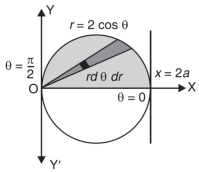
Eq. (1) represent a circle whose radius is 1 and centre is (1, 0)
Lower limit of y is zero.
Region of integration in upper half circle,
First, we will convert into polar coordinates,
By putting
x by r cos θ and y by r sin θ, dy dx by r dr dθ,
Limits of r are0 to 2 cos θ and limits of θ are from 0 to π / 2.



Example-3: Evaluate 
Sol. Let the integral,
I = 
=




Put x = sin θ


= π / 24 ans.
Triple integrals
Definition: Let f (x, y, z) be a function which is continuous at every point of the finite region (Volume V) of three-dimensional space. Divide the region V into n sub regions of respective volumes . Let (
. Let ( ) be a point in the
) be a point in the  sub region then the sum:
sub region then the sum:

Is called triple integration of f (x, y, z) over the region V provided limit on R.H.S of above Equation exists.
Spherical Polar Coordinates
1) For the spheres x2 + y2 + z2 = r2
Put x = r sin θ cos x, y = r sin θ sin , z = r cos θ
Dx dy dz = r2 sin θ dr dθ d
(a) For complete sphere x2 + y2 + z2 = a2, θ = 0 to π, = 0 to 2π, r = 0 to a.
(b) For hemisphere x2 + y2 + z2 = a2 , z > 0, θ = 0 to π/2, = 0 to 2π, r = 0 to a
(c) For positive octant of a sphere x2 + y2 + z2 = a2, θ = 0 to π/2, r = 0 to a
2) For ellipsoid x2/a2 + y2/b2 + z2/c2 = 1
Put x = ar sin θ cos , y = b r sin θ sin , z = c r sin θ
Dx dy dz = abc r2 dr dθ d, θ = 0 to π, = 0 to 2π, r = 0 to 1
Dirichlets Theorem: -


Where the integral is extended to all positive values of the variables subjected to the condition 
Ex.1: Evaluate

Solution: Let
I = 
= 
(Assuming m =  )
)
=  dxdy
dxdy
= 
=
=  dx
dx
=  dx
dx
= 
=
I =
Ex.2: Evaluate  Where V is annulus between the spheres
Where V is annulus between the spheres 
And (
( )
)
Solution: It is convenient to transform the triple integral into spherical polar co-ordinate by putting
 ,
,  ,
, 
 , dxdydz=
, dxdydz= sin
sin drd
drd d
d ,
,
 and
and

For the positive octant, r varies from r =b to r =a,  varies from
varies from 
And varies from
varies from 
I= 
= 8
=8
=8
=8
=8 log
= 8 log
I= 8 log I = 4 log
I = 4 log
Ex.3: Evaluate 
Solution: -








= 1/18 [e12 – 2e6 – 9e4 + 18e2 – 8]
Ex.4: Evaluate
 , taken through out the volume of the sphere x2 + y2 + z2 = 1 in positive octant.
, taken through out the volume of the sphere x2 + y2 + z2 = 1 in positive octant.
Solution:
Put x = r sin θ sin , z = r cos θ, dx dy dz = r2 sin θ dr dθ d
θ = 0 to π/2, r= 0 to 1 and x2 + y2 + z2 = r2 φ = 0 to π/2




Where I1 =  put r = sin t
put r = sin t
Dr = cos dt r 0 1
t 0 π/2




= π/4 . ()π/20
= π/4 . π/2
= π2/8
NOTES:
The volume of solid is given by
Volume =
In Spherical polar system

In cylindrical polar system

Ex.1: Find Volume of the tetrahedron bounded by the co-ordinate’s planes and the plane

Solution: Volume = ………. (1)
………. (1)
Put  ,
, 

From equation (1) we have
V = 
=24
=24 (u+v+w=1) By Dirichlet’s theorem.
(u+v+w=1) By Dirichlet’s theorem.
=24 
= =
= = 4
= 4
Volume =4
Ex.2: Find volume common to the cylinders ,
, .
.
Solution: For given cylinders,
 ,
,  .
.
Z varies from
Z=- to z =
to z = 
Y varies from
y= - to y =
to y = 
x varies from x= -a to x = a
By symmetry,
Required volume= 8 (volume in the first octant)
=8 
=8
= 8 dx
dx
=8
=8
=8
Volume = 16
Ex.3: Evaluate

Solution
Put x = r sin θ cos , y = r sin θ sin , z = r cos θ
θ = 0 to π, = 0 to 2π, r = 0 to 1, dx dy dz = r2 sin θ dr dθ d
I = 

= 





= 4a7π / 35
Ex.4:
Integrate  through out the volume bounded x = 0, y=0, z = 0, x/a + y/b+z/c = 1.
through out the volume bounded x = 0, y=0, z = 0, x/a + y/b+z/c = 1.
Solution: x = au dx = a du
y = bv dy = b dv
z = cw dz = c dw
I = 
= 
= a3 b2 c2 
= a3b2c2 
= a3b2c2 
= a3b2c2 2!/7!
= a3b2c2/2520
Ex.5:
Evaluate  throught the volume of the ellipsoid
throught the volume of the ellipsoid 
Solution: Put
x = ar sin θ cos
y = br sin θ sin
z = cr cos θ
Dxdydz = abc r2 drdθd
θ = 0 to π, = 0 to 2π, r = 0 to 1
I = 
= abc 
Put r = sin t dr = cos t dt
If r = 0 then t = 0 and r = 1 then t = π/2
Abc 
= abc 
= abcπ/16 
= abcπ/16 
= abcπ/8 
= abcπ2/4
Example 1: Evaluate

By changing the order of integration.
Solution: The given limits are (inner) y from x to π/2; (Outer) x from 0 to π/2.
We use these to sketch the region of integration.
The given limits have inner variable y. To reverse the order of integration we use horizontal stripes. The limits in this order are
(inner) x from 0 to y; (outer) y from 0 to π/2.
So the integral becomes

We compute the inner, then the outer integrals.
Inner:  Outer : - cos
Outer : - cos  =1
=1
Change of Order of Integration:

This is the case where limits are constants. But if they are variables, then by changing the order of integration, the limits of integration also changes.
A rough sketch helps in fixing the new limits of integration.
Example 1: Change the order of integration in 
Of hence evaluate the same.
Solution:
y = x2 & y = 2 - x
Pt. Of interaction:
x2 + x + 2 = 0
x = 1, 2
y = 1
(1, 1) is coordinate for A
Region of interaction is divided into 2 parts OAM and MAB
For region OAM:
0 ≤ y ≤ 1, 0 ≤ x ≤ y
For region MAB:
1 ≤ y ≤ 2, 0 ≤ x ≤ 2 –y






Example 2: Change the order of integration of evaluate

Solution:
y = x2/4a & y = 2ax
x2 = 4ay & y2 = 4ax
Pt. Of intersection
x4/16a2 = 4ax
x4 – 64 a3x3 = 0
x = 0, 4a
pts, are (0, 0), (4a, 4a)







Determine the image of a region under a given transformation of variables.
Compute the Jacobian of a given transformation.
Evaluate a double integral using a change of variables.
Evaluate a triple integral using a change of variables.
Example 1:
Evaluate  .dA
.dA
Solution:
Here’s is the region bounded by the lines on the real lines
X+ y=0; x+ y=-1
x- y=0 ; x-y = 8
Let
u=x+ y , 0 u 1
v=x-y, 0 v 8
Now we have two choices
*solve for x and y if possible
*use the inverse transmission
Solving for x and y
[ u = x+y] + [ v = x – y] = u + v = 2x
[ u = x+y ] – [ v = x – y] = u – v = 2y
X=1/2(u)+1/2(v) and y =1/2(u-1/2(v)
Using of inverse method:
 and J(x, y) . J(u, v) = 1
and J(x, y) . J(u, v) = 1
J(u, v) = 1/J(u, v)
J(u, v) = 
J(u, v) = (- ¼ ) – ( ¼ ) = - ½


½ (e – 1) 
J(u, v) = 6(e – 1)
Example 2:
Evaluate  .dA
.dA
Solution:
Here s is the region bounded by the lines on the real lines
X - 2y=0; x - 2y= 4
3x-y=1 ;3 x-y = 8
Let
u=x – 2y
v= 3x- y
Now we have two choices
*solve for x and y if possible
*use the inverse transmission
Using of inverse method:
 and J(x, y) . J(u, v) = 1
and J(x, y) . J(u, v) = 1
J(u, v) = 1/J(u, v)
J(u, v) = 
where u/x = 1, u/y = - 2, v/x = 3, v/x = - 1
J(x, y) = 
J(u, v) = 1/J(x, y) J(u, v) = 1/5
Example 3:
Given a plane z= 3x+4y+2 that lies above the rectangle [0,5] [1,4]. Find the surface area
Solution:
The area of the surface with equation z=f(x,y),(x,y)∈ D ,where fx and fy are continuous,
Is A(S)= dA
dA
We have z=2+3x+4y.
Then, z/x = 3 and z/y = 4
A(S) =  dA
dA
From the dimensions of the rectangle, we get the limits of x as (0,5) and the limits of y as(1,4)
On substituting the known values in the expression for area ,we get
A(S) = 
Evaluate the iterated integral.
A(S) =
= 
=15 26
Example 4:
As an example, let us consider the following integral in two dimensions:
I= 
Solution: Where C is a straight line from the origin to (1,1), as shown the figure, Let s be the arc length measured from the origin. We then have
x =s cos θ = s/2
y=s sin θ = s/2
The endpoint (1,1) corresponds to s=2.Thus , the line integral becomes

Definition: evaluating triple integrals is similar to evaluating nested functions: you work from inside out. Triple integrals look scary, but if you take them step by step, they’re no kore difficult than regular integrals. You start in the centre and work your way out. For example, begin by separating two inner integrals.
Example 1: Evaluate the following:

Solution: 



Example 2: Evaluate the following:

Solution: let I = 


Example 3: Evaluate the following triple integral

Solution: let 




Area of double integration
Area in Cartesian coordinates-
Example-1: Find the area enclosed by two curves using double integration.
y = 2 – x and y² = 2 (2 – x)
Sol. Let,
y = 2 – x ………………. (1)
And y² = 2 (2 – x) ………………. (2)
On solving eq. (1) and (2)
We get the intersection points (2,0) and (0,2),
We know that,
Area = 
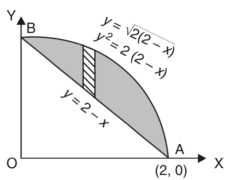
Here we will find the area as below,
Area = 
= 
= 
= 
Which gives,
= (- 4 + 4 /2) + 8 / 3 = 2 / 3.
Example-2: Find the area between the parabola y ² = 4ax and another parabola x² = 4ay.
Sol. Let,
y² = 4ax ………………. (1)
And
x² = 4ay…………………. (2)
Then if we solve these equations, we get the values of points where these two curves intersect
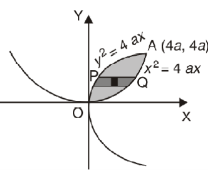
x varies from y²/4a to  and y varies from o to 4a,
and y varies from o to 4a,
Now using the concept of double integral,
Area = 
= 
= 
Area in polar coordinates-
Example-3: Find the area lying inside the cardioid r = a(1+cosθ) and outside the circle r = a, by using double integration.
Sol. We have,
r = a(1+cosθ) ……………………. (1)
And
r = a ………………………………. (2)
On solving these equations by eliminating r, we get
a(1+cosθ) = a
(1+cosθ) = 1
Cosθ = 0
Here a θ varies from – π/2 to π/2
Limit of r will be a and 1+cosθ)





Which is the required area.
Example-4: Find the are lying inside a cardioid r = 1 + cosθ and outside the parabola r (1 + cosθ) = 1.
Sol. Let,
r = 1 + cosθ ……………………. (1)
r (1 + cosθ) = 1……………………. (2)
Solving these equations, we get
(1 + cosθ) (1 + cosθ) = 1
(1 + cosθ) ² = 1
1 + cosθ = 1
Cosθ = 0
θ = ±π / 2
So that, limits of r are,
1 + cosθ and 1 / 1 + cosθ
The area can be founded as below,
= 
= ½ 
= 
= 
= 
= 
= [ θ + θ/2 + sin 2θ/4 + 2 sin θ – ¼ (2 tan θ/2 + 2/3 tan3 θ/2)]π/20
= [π/2 + π/4 +0+ 2 sin π/2 – ½ tan π/4 – 1/6 tan3 π/4] = [3π/4 + 2 – ½ - 1/6 ] = [3π/4 + 4/3]
Double integrals as volumes
Suppose we have a curve y = f(x) is revolved about an axis, then a solid is generated, now we need to find out the volume of the solid generated,
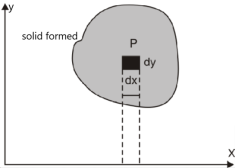
The formula for volume of the solid generated about x-axis,

Example-1: Calculate the volume generated by the revolution of a cardioid,
r = a (1 – cosθ) about its axis
Sol. Here, r = a (1 – cosθ)
Volume =



=
= 2πa3/3 
Which is the volume of generated by cardioid.
Example-2: Find the volume generated by revolving a circle x ² + y² = 4 about the line x= 3.
Sol. We know that,
Volume = 
Here , PQ = 3 – x,
= 
= 2π 

= 2π  (3y – xy)+4-x2-4-x2
(3y – xy)+4-x2-4-x2
= 2π  [34-x2 - x4-x2 + 34-x2 - x4-x2]
[34-x2 - x4-x2 + 34-x2 - x4-x2]
= 4π[3 4 – x2 - x4 – x2] dx = 4π [ 3 x/2 4-x2 + 3 4/2 sin-1 x/2 + 1/3(4 – x2)3/2]2-2
= 4π[ 6 π/2+ 6π/2] = 24π2
The volume is 24π².
Example-3: Calculate the volume under the surface z = 3 + x² - 2y over the region R defined as 0≤ x ≤ 1 and -x ≤ y ≤ x
Sol. The is a double integral of z = 3 + x² - 2y over the region R
Volume will be,




References:
- E. Kreyszig, “Advanced Engineering Mathematics”, John Wiley & Sons, 2006.
- P. G. Hoel, S. C. Port And C. J. Stone, “Introduction To Probability Theory”, Universal Book Stall, 2003.
- S. Ross, “A First Course in Probability”, Pearson Education India, 2002.
- W. Feller, “An Introduction To Probability Theory and Its Applications”, Vol. 1, Wiley, 1968.
- N.P. Bali and M. Goyal, “A Text Book of Engineering Mathematics”, Laxmi Publications, 2010.
Unit - 1
Multivariable Integral Calculus
Double integral –
Before studying about multiple integrals, first let’s go through the definition of definition of definite integrals for function of single variable.
As we know, the integral

Where is belongs to the limit a ≤ x ≤ b
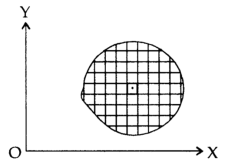
This integral can be written as follows-

Now suppose we have a function f (x, y) of two variables x and y in two-dimensional finite region Rin xy-plane.
Then the double integration over region R can be evaluated by two successive integrations

Evaluation of double integrals-
If A is described as 
Then,
 ]dx
]dx
Let do some examples to understand more about double integration-
Example-1: Evaluate  , where dA is the small area in xy-plane.
, where dA is the small area in xy-plane.
Sol. Let, I = 
= 
= 
= 
= 84 sq. Unit.
Which is the required area.
Example-2: Evaluate 
Sol. Let us suppose the integral is I,
I = 
Put c = 1 – x in I, we get
I = 
Suppose, y = ct
Then dy = c
Now we get,
I = 
I = 
I = 
I = 
I =
As we know that by beta function,

Which gives,



Now put the value of c, we get

= π/2 [ ¾ (1) – 3/7 (1) – ¾ (-1) + 3/7 (-1)] = π/2 [9/14] = 9π/28
Example-3: Evaluate the following double integral,

Sol. Let,
I = 
On solving the integral, we get



= 5π/8
Double integration in polar coordination
In polar coordinates, we need to evaluate

Over the region bounded by θ1 and θ2.
And the curves r1(θ) and r2(θ)
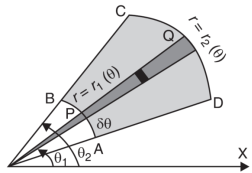
Example-1: Evaluate the following by changing to polar coordinates,

Sol. In this problem, the limits for y are 0 to  and the limits for are 0 to 2.
and the limits for are 0 to 2.
Suppose,
y = 
Squaring both sides,
y² = 2x - x²
x² + y² = 2x
But in polar coordinates,
We have,
r² = 2r cos θ
r = 2 cos θ
From the region of integration, r lies from 0 to 2 cos θ and θ varies from 0 to π / 2.
As we know in case of polar coordinates,
Replace x by r cos θ and y by r sin θ, dy dx by r dr dθ,
We get,


Example-2: Evaluate the following integral by converting into polar coordinates.

Sol. Here limits of y,
y = 
y² = 2x - x²
x² + y² = 2x
x² + y² - 2x = 0 ……………… (1)
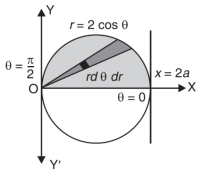
Eq. (1) represent a circle whose radius is 1 and centre is (1, 0)
Lower limit of y is zero.
Region of integration in upper half circle,
First, we will convert into polar coordinates,
By putting
x by r cos θ and y by r sin θ, dy dx by r dr dθ,
Limits of r are0 to 2 cos θ and limits of θ are from 0 to π / 2.



Example-3: Evaluate 
Sol. Let the integral,
I = 
=




Put x = sin θ


= π / 24 ans.
Triple integrals
Definition: Let f (x, y, z) be a function which is continuous at every point of the finite region (Volume V) of three-dimensional space. Divide the region V into n sub regions of respective volumes . Let (
. Let ( ) be a point in the
) be a point in the  sub region then the sum:
sub region then the sum:

Is called triple integration of f (x, y, z) over the region V provided limit on R.H.S of above Equation exists.
Spherical Polar Coordinates
1) For the spheres x2 + y2 + z2 = r2
Put x = r sin θ cos x, y = r sin θ sin , z = r cos θ
Dx dy dz = r2 sin θ dr dθ d
(a) For complete sphere x2 + y2 + z2 = a2, θ = 0 to π, = 0 to 2π, r = 0 to a.
(b) For hemisphere x2 + y2 + z2 = a2 , z > 0, θ = 0 to π/2, = 0 to 2π, r = 0 to a
(c) For positive octant of a sphere x2 + y2 + z2 = a2, θ = 0 to π/2, r = 0 to a
2) For ellipsoid x2/a2 + y2/b2 + z2/c2 = 1
Put x = ar sin θ cos , y = b r sin θ sin , z = c r sin θ
Dx dy dz = abc r2 dr dθ d, θ = 0 to π, = 0 to 2π, r = 0 to 1
Dirichlets Theorem: -


Where the integral is extended to all positive values of the variables subjected to the condition 
Ex.1: Evaluate

Solution: Let
I = 
= 
(Assuming m =  )
)
=  dxdy
dxdy
= 
=
=  dx
dx
=  dx
dx
= 
=
I =
Ex.2: Evaluate  Where V is annulus between the spheres
Where V is annulus between the spheres 
And (
( )
)
Solution: It is convenient to transform the triple integral into spherical polar co-ordinate by putting
 ,
,  ,
, 
 , dxdydz=
, dxdydz= sin
sin drd
drd d
d ,
,
 and
and

For the positive octant, r varies from r =b to r =a,  varies from
varies from 
And varies from
varies from 
I= 
= 8
=8
=8
=8
=8 log
= 8 log
I= 8 log I = 4 log
I = 4 log
Ex.3: Evaluate 
Solution: -








= 1/18 [e12 – 2e6 – 9e4 + 18e2 – 8]
Ex.4: Evaluate
 , taken through out the volume of the sphere x2 + y2 + z2 = 1 in positive octant.
, taken through out the volume of the sphere x2 + y2 + z2 = 1 in positive octant.
Solution:
Put x = r sin θ sin , z = r cos θ, dx dy dz = r2 sin θ dr dθ d
θ = 0 to π/2, r= 0 to 1 and x2 + y2 + z2 = r2 φ = 0 to π/2




Where I1 =  put r = sin t
put r = sin t
Dr = cos dt r 0 1
t 0 π/2




= π/4 . ()π/20
= π/4 . π/2
= π2/8
NOTES:
The volume of solid is given by
Volume =
In Spherical polar system

In cylindrical polar system

Ex.1: Find Volume of the tetrahedron bounded by the co-ordinate’s planes and the plane

Solution: Volume = ………. (1)
………. (1)
Put  ,
, 

From equation (1) we have
V = 
=24
=24 (u+v+w=1) By Dirichlet’s theorem.
(u+v+w=1) By Dirichlet’s theorem.
=24 
= =
= = 4
= 4
Volume =4
Ex.2: Find volume common to the cylinders ,
, .
.
Solution: For given cylinders,
 ,
,  .
.
Z varies from
Z=- to z =
to z = 
Y varies from
y= - to y =
to y = 
x varies from x= -a to x = a
By symmetry,
Required volume= 8 (volume in the first octant)
=8 
=8
= 8 dx
dx
=8
=8
=8
Volume = 16
Ex.3: Evaluate

Solution
Put x = r sin θ cos , y = r sin θ sin , z = r cos θ
θ = 0 to π, = 0 to 2π, r = 0 to 1, dx dy dz = r2 sin θ dr dθ d
I = 

= 





= 4a7π / 35
Ex.4:
Integrate  through out the volume bounded x = 0, y=0, z = 0, x/a + y/b+z/c = 1.
through out the volume bounded x = 0, y=0, z = 0, x/a + y/b+z/c = 1.
Solution: x = au dx = a du
y = bv dy = b dv
z = cw dz = c dw
I = 
= 
= a3 b2 c2 
= a3b2c2 
= a3b2c2 
= a3b2c2 2!/7!
= a3b2c2/2520
Ex.5:
Evaluate  throught the volume of the ellipsoid
throught the volume of the ellipsoid 
Solution: Put
x = ar sin θ cos
y = br sin θ sin
z = cr cos θ
Dxdydz = abc r2 drdθd
θ = 0 to π, = 0 to 2π, r = 0 to 1
I = 
= abc 
Put r = sin t dr = cos t dt
If r = 0 then t = 0 and r = 1 then t = π/2
Abc 
= abc 
= abcπ/16 
= abcπ/16 
= abcπ/8 
= abcπ2/4
Example 1: Evaluate

By changing the order of integration.
Solution: The given limits are (inner) y from x to π/2; (Outer) x from 0 to π/2.
We use these to sketch the region of integration.
The given limits have inner variable y. To reverse the order of integration we use horizontal stripes. The limits in this order are
(inner) x from 0 to y; (outer) y from 0 to π/2.
So the integral becomes

We compute the inner, then the outer integrals.
Inner:  Outer : - cos
Outer : - cos  =1
=1
Change of Order of Integration:

This is the case where limits are constants. But if they are variables, then by changing the order of integration, the limits of integration also changes.
A rough sketch helps in fixing the new limits of integration.
Example 1: Change the order of integration in 
Of hence evaluate the same.
Solution:
y = x2 & y = 2 - x
Pt. Of interaction:
x2 + x + 2 = 0
x = 1, 2
y = 1
(1, 1) is coordinate for A
Region of interaction is divided into 2 parts OAM and MAB
For region OAM:
0 ≤ y ≤ 1, 0 ≤ x ≤ y
For region MAB:
1 ≤ y ≤ 2, 0 ≤ x ≤ 2 –y






Example 2: Change the order of integration of evaluate

Solution:
y = x2/4a & y = 2ax
x2 = 4ay & y2 = 4ax
Pt. Of intersection
x4/16a2 = 4ax
x4 – 64 a3x3 = 0
x = 0, 4a
pts, are (0, 0), (4a, 4a)







Determine the image of a region under a given transformation of variables.
Compute the Jacobian of a given transformation.
Evaluate a double integral using a change of variables.
Evaluate a triple integral using a change of variables.
Example 1:
Evaluate  .dA
.dA
Solution:
Here’s is the region bounded by the lines on the real lines
X+ y=0; x+ y=-1
x- y=0 ; x-y = 8
Let
u=x+ y , 0 u 1
v=x-y, 0 v 8
Now we have two choices
*solve for x and y if possible
*use the inverse transmission
Solving for x and y
[ u = x+y] + [ v = x – y] = u + v = 2x
[ u = x+y ] – [ v = x – y] = u – v = 2y
X=1/2(u)+1/2(v) and y =1/2(u-1/2(v)
Using of inverse method:
 and J(x, y) . J(u, v) = 1
and J(x, y) . J(u, v) = 1
J(u, v) = 1/J(u, v)
J(u, v) = 
J(u, v) = (- ¼ ) – ( ¼ ) = - ½


½ (e – 1) 
J(u, v) = 6(e – 1)
Example 2:
Evaluate  .dA
.dA
Solution:
Here s is the region bounded by the lines on the real lines
X - 2y=0; x - 2y= 4
3x-y=1 ;3 x-y = 8
Let
u=x – 2y
v= 3x- y
Now we have two choices
*solve for x and y if possible
*use the inverse transmission
Using of inverse method:
 and J(x, y) . J(u, v) = 1
and J(x, y) . J(u, v) = 1
J(u, v) = 1/J(u, v)
J(u, v) = 
where u/x = 1, u/y = - 2, v/x = 3, v/x = - 1
J(x, y) = 
J(u, v) = 1/J(x, y) J(u, v) = 1/5
Example 3:
Given a plane z= 3x+4y+2 that lies above the rectangle [0,5] [1,4]. Find the surface area
Solution:
The area of the surface with equation z=f(x,y),(x,y)∈ D ,where fx and fy are continuous,
Is A(S)= dA
dA
We have z=2+3x+4y.
Then, z/x = 3 and z/y = 4
A(S) =  dA
dA
From the dimensions of the rectangle, we get the limits of x as (0,5) and the limits of y as(1,4)
On substituting the known values in the expression for area ,we get
A(S) = 
Evaluate the iterated integral.
A(S) =
= 
=15 26
Example 4:
As an example, let us consider the following integral in two dimensions:
I= 
Solution: Where C is a straight line from the origin to (1,1), as shown the figure, Let s be the arc length measured from the origin. We then have
x =s cos θ = s/2
y=s sin θ = s/2
The endpoint (1,1) corresponds to s=2.Thus , the line integral becomes

Unit - 1
Multivariable Integral Calculus
Unit - 1
Multivariable Integral Calculus
Double integral –
Before studying about multiple integrals, first let’s go through the definition of definition of definite integrals for function of single variable.
As we know, the integral

Where is belongs to the limit a ≤ x ≤ b
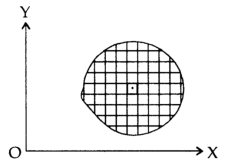
This integral can be written as follows-

Now suppose we have a function f (x, y) of two variables x and y in two-dimensional finite region Rin xy-plane.
Then the double integration over region R can be evaluated by two successive integrations

Evaluation of double integrals-
If A is described as 
Then,
 ]dx
]dx
Let do some examples to understand more about double integration-
Example-1: Evaluate  , where dA is the small area in xy-plane.
, where dA is the small area in xy-plane.
Sol. Let, I = 
= 
= 
= 
= 84 sq. Unit.
Which is the required area.
Example-2: Evaluate 
Sol. Let us suppose the integral is I,
I = 
Put c = 1 – x in I, we get
I = 
Suppose, y = ct
Then dy = c
Now we get,
I = 
I = 
I = 
I = 
I =
As we know that by beta function,

Which gives,



Now put the value of c, we get

= π/2 [ ¾ (1) – 3/7 (1) – ¾ (-1) + 3/7 (-1)] = π/2 [9/14] = 9π/28
Example-3: Evaluate the following double integral,

Sol. Let,
I = 
On solving the integral, we get



= 5π/8
Double integration in polar coordination
In polar coordinates, we need to evaluate

Over the region bounded by θ1 and θ2.
And the curves r1(θ) and r2(θ)
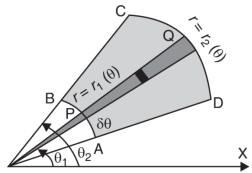
Example-1: Evaluate the following by changing to polar coordinates,

Sol. In this problem, the limits for y are 0 to  and the limits for are 0 to 2.
and the limits for are 0 to 2.
Suppose,
y = 
Squaring both sides,
y² = 2x - x²
x² + y² = 2x
But in polar coordinates,
We have,
r² = 2r cos θ
r = 2 cos θ
From the region of integration, r lies from 0 to 2 cos θ and θ varies from 0 to π / 2.
As we know in case of polar coordinates,
Replace x by r cos θ and y by r sin θ, dy dx by r dr dθ,
We get,


Example-2: Evaluate the following integral by converting into polar coordinates.

Sol. Here limits of y,
y = 
y² = 2x - x²
x² + y² = 2x
x² + y² - 2x = 0 ……………… (1)
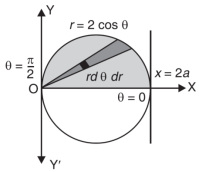
Eq. (1) represent a circle whose radius is 1 and centre is (1, 0)
Lower limit of y is zero.
Region of integration in upper half circle,
First, we will convert into polar coordinates,
By putting
x by r cos θ and y by r sin θ, dy dx by r dr dθ,
Limits of r are0 to 2 cos θ and limits of θ are from 0 to π / 2.



Example-3: Evaluate 
Sol. Let the integral,
I = 
=




Put x = sin θ


= π / 24 ans.
Triple integrals
Definition: Let f (x, y, z) be a function which is continuous at every point of the finite region (Volume V) of three-dimensional space. Divide the region V into n sub regions of respective volumes . Let (
. Let ( ) be a point in the
) be a point in the  sub region then the sum:
sub region then the sum:

Is called triple integration of f (x, y, z) over the region V provided limit on R.H.S of above Equation exists.
Spherical Polar Coordinates
1) For the spheres x2 + y2 + z2 = r2
Put x = r sin θ cos x, y = r sin θ sin , z = r cos θ
Dx dy dz = r2 sin θ dr dθ d
(a) For complete sphere x2 + y2 + z2 = a2, θ = 0 to π, = 0 to 2π, r = 0 to a.
(b) For hemisphere x2 + y2 + z2 = a2 , z > 0, θ = 0 to π/2, = 0 to 2π, r = 0 to a
(c) For positive octant of a sphere x2 + y2 + z2 = a2, θ = 0 to π/2, r = 0 to a
2) For ellipsoid x2/a2 + y2/b2 + z2/c2 = 1
Put x = ar sin θ cos , y = b r sin θ sin , z = c r sin θ
Dx dy dz = abc r2 dr dθ d, θ = 0 to π, = 0 to 2π, r = 0 to 1
Dirichlets Theorem: -


Where the integral is extended to all positive values of the variables subjected to the condition 
Ex.1: Evaluate

Solution: Let
I = 
= 
(Assuming m =  )
)
=  dxdy
dxdy
= 
=
=  dx
dx
=  dx
dx
= 
=
I =
Ex.2: Evaluate  Where V is annulus between the spheres
Where V is annulus between the spheres 
And (
( )
)
Solution: It is convenient to transform the triple integral into spherical polar co-ordinate by putting
 ,
,  ,
, 
 , dxdydz=
, dxdydz= sin
sin drd
drd d
d ,
,
 and
and

For the positive octant, r varies from r =b to r =a,  varies from
varies from 
And varies from
varies from 
I= 
= 8
=8
=8
=8
=8 log
= 8 log
I= 8 log I = 4 log
I = 4 log
Ex.3: Evaluate 
Solution: -








= 1/18 [e12 – 2e6 – 9e4 + 18e2 – 8]
Ex.4: Evaluate
 , taken through out the volume of the sphere x2 + y2 + z2 = 1 in positive octant.
, taken through out the volume of the sphere x2 + y2 + z2 = 1 in positive octant.
Solution:
Put x = r sin θ sin , z = r cos θ, dx dy dz = r2 sin θ dr dθ d
θ = 0 to π/2, r= 0 to 1 and x2 + y2 + z2 = r2 φ = 0 to π/2




Where I1 =  put r = sin t
put r = sin t
Dr = cos dt r 0 1
t 0 π/2




= π/4 . ()π/20
= π/4 . π/2
= π2/8
NOTES:
The volume of solid is given by
Volume =
In Spherical polar system

In cylindrical polar system

Ex.1: Find Volume of the tetrahedron bounded by the co-ordinate’s planes and the plane

Solution: Volume = ………. (1)
………. (1)
Put  ,
, 

From equation (1) we have
V = 
=24
=24 (u+v+w=1) By Dirichlet’s theorem.
(u+v+w=1) By Dirichlet’s theorem.
=24 
= =
= = 4
= 4
Volume =4
Ex.2: Find volume common to the cylinders ,
, .
.
Solution: For given cylinders,
 ,
,  .
.
Z varies from
Z=- to z =
to z = 
Y varies from
y= - to y =
to y = 
x varies from x= -a to x = a
By symmetry,
Required volume= 8 (volume in the first octant)
=8 
=8
= 8 dx
dx
=8
=8
=8
Volume = 16
Ex.3: Evaluate

Solution
Put x = r sin θ cos , y = r sin θ sin , z = r cos θ
θ = 0 to π, = 0 to 2π, r = 0 to 1, dx dy dz = r2 sin θ dr dθ d
I = 

= 





= 4a7π / 35
Ex.4:
Integrate  through out the volume bounded x = 0, y=0, z = 0, x/a + y/b+z/c = 1.
through out the volume bounded x = 0, y=0, z = 0, x/a + y/b+z/c = 1.
Solution: x = au dx = a du
y = bv dy = b dv
z = cw dz = c dw
I = 
= 
= a3 b2 c2 
= a3b2c2 
= a3b2c2 
= a3b2c2 2!/7!
= a3b2c2/2520
Ex.5:
Evaluate  throught the volume of the ellipsoid
throught the volume of the ellipsoid 
Solution: Put
x = ar sin θ cos
y = br sin θ sin
z = cr cos θ
Dxdydz = abc r2 drdθd
θ = 0 to π, = 0 to 2π, r = 0 to 1
I = 
= abc 
Put r = sin t dr = cos t dt
If r = 0 then t = 0 and r = 1 then t = π/2
Abc 
= abc 
= abcπ/16 
= abcπ/16 
= abcπ/8 
= abcπ2/4
Example 1: Evaluate

By changing the order of integration.
Solution: The given limits are (inner) y from x to π/2; (Outer) x from 0 to π/2.
We use these to sketch the region of integration.
The given limits have inner variable y. To reverse the order of integration we use horizontal stripes. The limits in this order are
(inner) x from 0 to y; (outer) y from 0 to π/2.
So the integral becomes

We compute the inner, then the outer integrals.
Inner:  Outer : - cos
Outer : - cos  =1
=1
Change of Order of Integration:

This is the case where limits are constants. But if they are variables, then by changing the order of integration, the limits of integration also changes.
A rough sketch helps in fixing the new limits of integration.
Example 1: Change the order of integration in 
Of hence evaluate the same.
Solution:
y = x2 & y = 2 - x
Pt. Of interaction:
x2 + x + 2 = 0
x = 1, 2
y = 1
(1, 1) is coordinate for A
Region of interaction is divided into 2 parts OAM and MAB
For region OAM:
0 ≤ y ≤ 1, 0 ≤ x ≤ y
For region MAB:
1 ≤ y ≤ 2, 0 ≤ x ≤ 2 –y






Example 2: Change the order of integration of evaluate

Solution:
y = x2/4a & y = 2ax
x2 = 4ay & y2 = 4ax
Pt. Of intersection
x4/16a2 = 4ax
x4 – 64 a3x3 = 0
x = 0, 4a
pts, are (0, 0), (4a, 4a)







Determine the image of a region under a given transformation of variables.
Compute the Jacobian of a given transformation.
Evaluate a double integral using a change of variables.
Evaluate a triple integral using a change of variables.
Example 1:
Evaluate  .dA
.dA
Solution:
Here’s is the region bounded by the lines on the real lines
X+ y=0; x+ y=-1
x- y=0 ; x-y = 8
Let
u=x+ y , 0 u 1
v=x-y, 0 v 8
Now we have two choices
*solve for x and y if possible
*use the inverse transmission
Solving for x and y
[ u = x+y] + [ v = x – y] = u + v = 2x
[ u = x+y ] – [ v = x – y] = u – v = 2y
X=1/2(u)+1/2(v) and y =1/2(u-1/2(v)
Using of inverse method:
 and J(x, y) . J(u, v) = 1
and J(x, y) . J(u, v) = 1
J(u, v) = 1/J(u, v)
J(u, v) = 
J(u, v) = (- ¼ ) – ( ¼ ) = - ½


½ (e – 1) 
J(u, v) = 6(e – 1)
Example 2:
Evaluate  .dA
.dA
Solution:
Here s is the region bounded by the lines on the real lines
X - 2y=0; x - 2y= 4
3x-y=1 ;3 x-y = 8
Let
u=x – 2y
v= 3x- y
Now we have two choices
*solve for x and y if possible
*use the inverse transmission
Using of inverse method:
 and J(x, y) . J(u, v) = 1
and J(x, y) . J(u, v) = 1
J(u, v) = 1/J(u, v)
J(u, v) = 
where u/x = 1, u/y = - 2, v/x = 3, v/x = - 1
J(x, y) = 
J(u, v) = 1/J(x, y) J(u, v) = 1/5
Example 3:
Given a plane z= 3x+4y+2 that lies above the rectangle [0,5] [1,4]. Find the surface area
Solution:
The area of the surface with equation z=f(x,y),(x,y)∈ D ,where fx and fy are continuous,
Is A(S)= dA
dA
We have z=2+3x+4y.
Then, z/x = 3 and z/y = 4
A(S) =  dA
dA
From the dimensions of the rectangle, we get the limits of x as (0,5) and the limits of y as(1,4)
On substituting the known values in the expression for area ,we get
A(S) = 
Evaluate the iterated integral.
A(S) =
= 
=15 26
Example 4:
As an example, let us consider the following integral in two dimensions:
I= 
Solution: Where C is a straight line from the origin to (1,1), as shown the figure, Let s be the arc length measured from the origin. We then have
x =s cos θ = s/2
y=s sin θ = s/2
The endpoint (1,1) corresponds to s=2.Thus , the line integral becomes

Unit - 1
Multivariable Integral Calculus
Unit - 1
Multivariable Integral Calculus
Double integral –
Before studying about multiple integrals, first let’s go through the definition of definition of definite integrals for function of single variable.
As we know, the integral

Where is belongs to the limit a ≤ x ≤ b
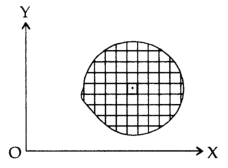
This integral can be written as follows-

Now suppose we have a function f (x, y) of two variables x and y in two-dimensional finite region Rin xy-plane.
Then the double integration over region R can be evaluated by two successive integrations

Evaluation of double integrals-
If A is described as 
Then,
 ]dx
]dx
Let do some examples to understand more about double integration-
Example-1: Evaluate  , where dA is the small area in xy-plane.
, where dA is the small area in xy-plane.
Sol. Let, I = 
= 
= 
= 
= 84 sq. Unit.
Which is the required area.
Example-2: Evaluate 
Sol. Let us suppose the integral is I,
I = 
Put c = 1 – x in I, we get
I = 
Suppose, y = ct
Then dy = c
Now we get,
I = 
I = 
I = 
I = 
I =
As we know that by beta function,

Which gives,



Now put the value of c, we get

= π/2 [ ¾ (1) – 3/7 (1) – ¾ (-1) + 3/7 (-1)] = π/2 [9/14] = 9π/28
Example-3: Evaluate the following double integral,

Sol. Let,
I = 
On solving the integral, we get



= 5π/8
Double integration in polar coordination
In polar coordinates, we need to evaluate

Over the region bounded by θ1 and θ2.
And the curves r1(θ) and r2(θ)
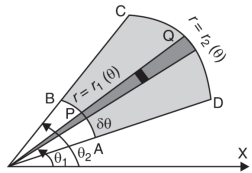
Example-1: Evaluate the following by changing to polar coordinates,

Sol. In this problem, the limits for y are 0 to  and the limits for are 0 to 2.
and the limits for are 0 to 2.
Suppose,
y = 
Squaring both sides,
y² = 2x - x²
x² + y² = 2x
But in polar coordinates,
We have,
r² = 2r cos θ
r = 2 cos θ
From the region of integration, r lies from 0 to 2 cos θ and θ varies from 0 to π / 2.
As we know in case of polar coordinates,
Replace x by r cos θ and y by r sin θ, dy dx by r dr dθ,
We get,


Example-2: Evaluate the following integral by converting into polar coordinates.

Sol. Here limits of y,
y = 
y² = 2x - x²
x² + y² = 2x
x² + y² - 2x = 0 ……………… (1)
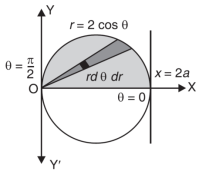
Eq. (1) represent a circle whose radius is 1 and centre is (1, 0)
Lower limit of y is zero.
Region of integration in upper half circle,
First, we will convert into polar coordinates,
By putting
x by r cos θ and y by r sin θ, dy dx by r dr dθ,
Limits of r are0 to 2 cos θ and limits of θ are from 0 to π / 2.



Example-3: Evaluate 
Sol. Let the integral,
I = 
=




Put x = sin θ


= π / 24 ans.
Triple integrals
Definition: Let f (x, y, z) be a function which is continuous at every point of the finite region (Volume V) of three-dimensional space. Divide the region V into n sub regions of respective volumes . Let (
. Let ( ) be a point in the
) be a point in the  sub region then the sum:
sub region then the sum:

Is called triple integration of f (x, y, z) over the region V provided limit on R.H.S of above Equation exists.
Spherical Polar Coordinates
1) For the spheres x2 + y2 + z2 = r2
Put x = r sin θ cos x, y = r sin θ sin , z = r cos θ
Dx dy dz = r2 sin θ dr dθ d
(a) For complete sphere x2 + y2 + z2 = a2, θ = 0 to π, = 0 to 2π, r = 0 to a.
(b) For hemisphere x2 + y2 + z2 = a2 , z > 0, θ = 0 to π/2, = 0 to 2π, r = 0 to a
(c) For positive octant of a sphere x2 + y2 + z2 = a2, θ = 0 to π/2, r = 0 to a
2) For ellipsoid x2/a2 + y2/b2 + z2/c2 = 1
Put x = ar sin θ cos , y = b r sin θ sin , z = c r sin θ
Dx dy dz = abc r2 dr dθ d, θ = 0 to π, = 0 to 2π, r = 0 to 1
Dirichlets Theorem: -


Where the integral is extended to all positive values of the variables subjected to the condition 
Ex.1: Evaluate

Solution: Let
I = 
= 
(Assuming m =  )
)
=  dxdy
dxdy
= 
=
=  dx
dx
=  dx
dx
= 
=
I =
Ex.2: Evaluate  Where V is annulus between the spheres
Where V is annulus between the spheres 
And (
( )
)
Solution: It is convenient to transform the triple integral into spherical polar co-ordinate by putting
 ,
,  ,
, 
 , dxdydz=
, dxdydz= sin
sin drd
drd d
d ,
,
 and
and

For the positive octant, r varies from r =b to r =a,  varies from
varies from 
And varies from
varies from 
I= 
= 8
=8
=8
=8
=8 log
= 8 log
I= 8 log I = 4 log
I = 4 log
Ex.3: Evaluate 
Solution: -








= 1/18 [e12 – 2e6 – 9e4 + 18e2 – 8]
Ex.4: Evaluate
 , taken through out the volume of the sphere x2 + y2 + z2 = 1 in positive octant.
, taken through out the volume of the sphere x2 + y2 + z2 = 1 in positive octant.
Solution:
Put x = r sin θ sin , z = r cos θ, dx dy dz = r2 sin θ dr dθ d
θ = 0 to π/2, r= 0 to 1 and x2 + y2 + z2 = r2 φ = 0 to π/2




Where I1 =  put r = sin t
put r = sin t
Dr = cos dt r 0 1
t 0 π/2




= π/4 . ()π/20
= π/4 . π/2
= π2/8
NOTES:
The volume of solid is given by
Volume =
In Spherical polar system

In cylindrical polar system

Ex.1: Find Volume of the tetrahedron bounded by the co-ordinate’s planes and the plane

Solution: Volume = ………. (1)
………. (1)
Put  ,
, 

From equation (1) we have
V = 
=24
=24 (u+v+w=1) By Dirichlet’s theorem.
(u+v+w=1) By Dirichlet’s theorem.
=24 
= =
= = 4
= 4
Volume =4
Ex.2: Find volume common to the cylinders ,
, .
.
Solution: For given cylinders,
 ,
,  .
.
Z varies from
Z=- to z =
to z = 
Y varies from
y= - to y =
to y = 
x varies from x= -a to x = a
By symmetry,
Required volume= 8 (volume in the first octant)
=8 
=8
= 8 dx
dx
=8
=8
=8
Volume = 16
Ex.3: Evaluate

Solution
Put x = r sin θ cos , y = r sin θ sin , z = r cos θ
θ = 0 to π, = 0 to 2π, r = 0 to 1, dx dy dz = r2 sin θ dr dθ d
I = 

= 





= 4a7π / 35
Ex.4:
Integrate  through out the volume bounded x = 0, y=0, z = 0, x/a + y/b+z/c = 1.
through out the volume bounded x = 0, y=0, z = 0, x/a + y/b+z/c = 1.
Solution: x = au dx = a du
y = bv dy = b dv
z = cw dz = c dw
I = 
= 
= a3 b2 c2 
= a3b2c2 
= a3b2c2 
= a3b2c2 2!/7!
= a3b2c2/2520
Ex.5:
Evaluate  throught the volume of the ellipsoid
throught the volume of the ellipsoid 
Solution: Put
x = ar sin θ cos
y = br sin θ sin
z = cr cos θ
Dxdydz = abc r2 drdθd
θ = 0 to π, = 0 to 2π, r = 0 to 1
I = 
= abc 
Put r = sin t dr = cos t dt
If r = 0 then t = 0 and r = 1 then t = π/2
Abc 
= abc 
= abcπ/16 
= abcπ/16 
= abcπ/8 
= abcπ2/4
Example 1: Evaluate

By changing the order of integration.
Solution: The given limits are (inner) y from x to π/2; (Outer) x from 0 to π/2.
We use these to sketch the region of integration.
The given limits have inner variable y. To reverse the order of integration we use horizontal stripes. The limits in this order are
(inner) x from 0 to y; (outer) y from 0 to π/2.
So the integral becomes

We compute the inner, then the outer integrals.
Inner:  Outer : - cos
Outer : - cos  =1
=1
Change of Order of Integration:

This is the case where limits are constants. But if they are variables, then by changing the order of integration, the limits of integration also changes.
A rough sketch helps in fixing the new limits of integration.
Example 1: Change the order of integration in 
Of hence evaluate the same.
Solution:
y = x2 & y = 2 - x
Pt. Of interaction:
x2 + x + 2 = 0
x = 1, 2
y = 1
(1, 1) is coordinate for A
Region of interaction is divided into 2 parts OAM and MAB
For region OAM:
0 ≤ y ≤ 1, 0 ≤ x ≤ y
For region MAB:
1 ≤ y ≤ 2, 0 ≤ x ≤ 2 –y






Example 2: Change the order of integration of evaluate

Solution:
y = x2/4a & y = 2ax
x2 = 4ay & y2 = 4ax
Pt. Of intersection
x4/16a2 = 4ax
x4 – 64 a3x3 = 0
x = 0, 4a
pts, are (0, 0), (4a, 4a)







Determine the image of a region under a given transformation of variables.
Compute the Jacobian of a given transformation.
Evaluate a double integral using a change of variables.
Evaluate a triple integral using a change of variables.
Example 1:
Evaluate  .dA
.dA
Solution:
Here’s is the region bounded by the lines on the real lines
X+ y=0; x+ y=-1
x- y=0 ; x-y = 8
Let
u=x+ y , 0 u 1
v=x-y, 0 v 8
Now we have two choices
*solve for x and y if possible
*use the inverse transmission
Solving for x and y
[ u = x+y] + [ v = x – y] = u + v = 2x
[ u = x+y ] – [ v = x – y] = u – v = 2y
X=1/2(u)+1/2(v) and y =1/2(u-1/2(v)
Using of inverse method:
 and J(x, y) . J(u, v) = 1
and J(x, y) . J(u, v) = 1
J(u, v) = 1/J(u, v)
J(u, v) = 
J(u, v) = (- ¼ ) – ( ¼ ) = - ½


½ (e – 1) 
J(u, v) = 6(e – 1)
Example 2:
Evaluate  .dA
.dA
Solution:
Here s is the region bounded by the lines on the real lines
X - 2y=0; x - 2y= 4
3x-y=1 ;3 x-y = 8
Let
u=x – 2y
v= 3x- y
Now we have two choices
*solve for x and y if possible
*use the inverse transmission
Using of inverse method:
 and J(x, y) . J(u, v) = 1
and J(x, y) . J(u, v) = 1
J(u, v) = 1/J(u, v)
J(u, v) = 
where u/x = 1, u/y = - 2, v/x = 3, v/x = - 1
J(x, y) = 
J(u, v) = 1/J(x, y) J(u, v) = 1/5
Example 3:
Given a plane z= 3x+4y+2 that lies above the rectangle [0,5] [1,4]. Find the surface area
Solution:
The area of the surface with equation z=f(x,y),(x,y)∈ D ,where fx and fy are continuous,
Is A(S)= dA
dA
We have z=2+3x+4y.
Then, z/x = 3 and z/y = 4
A(S) =  dA
dA
From the dimensions of the rectangle, we get the limits of x as (0,5) and the limits of y as(1,4)
On substituting the known values in the expression for area ,we get
A(S) = 
Evaluate the iterated integral.
A(S) =
= 
=15 26
Example 4:
As an example, let us consider the following integral in two dimensions:
I= 
Solution: Where C is a straight line from the origin to (1,1), as shown the figure, Let s be the arc length measured from the origin. We then have
x =s cos θ = s/2
y=s sin θ = s/2
The endpoint (1,1) corresponds to s=2.Thus , the line integral becomes

Definition: evaluating triple integrals is similar to evaluating nested functions: you work from inside out. Triple integrals look scary, but if you take them step by step, they’re no kore difficult than regular integrals. You start in the centre and work your way out. For example, begin by separating two inner integrals.
Example 1: Evaluate the following:

Solution: 



Example 2: Evaluate the following:

Solution: let I = 


Example 3: Evaluate the following triple integral

Solution: let 




Area of double integration
Area in Cartesian coordinates-
Example-1: Find the area enclosed by two curves using double integration.
y = 2 – x and y² = 2 (2 – x)
Sol. Let,
y = 2 – x ………………. (1)
And y² = 2 (2 – x) ………………. (2)
On solving eq. (1) and (2)
We get the intersection points (2,0) and (0,2),
We know that,
Area = 
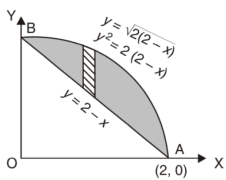
Here we will find the area as below,
Area = 
= 
= 
= 
Which gives,
= (- 4 + 4 /2) + 8 / 3 = 2 / 3.
Example-2: Find the area between the parabola y ² = 4ax and another parabola x² = 4ay.
Sol. Let,
y² = 4ax ………………. (1)
And
x² = 4ay…………………. (2)
Then if we solve these equations, we get the values of points where these two curves intersect
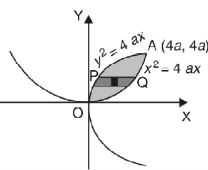
x varies from y²/4a to  and y varies from o to 4a,
and y varies from o to 4a,
Now using the concept of double integral,
Area = 
= 
= 
Area in polar coordinates-
Example-3: Find the area lying inside the cardioid r = a(1+cosθ) and outside the circle r = a, by using double integration.
Sol. We have,
r = a(1+cosθ) ……………………. (1)
And
r = a ………………………………. (2)
On solving these equations by eliminating r, we get
a(1+cosθ) = a
(1+cosθ) = 1
Cosθ = 0
Here a θ varies from – π/2 to π/2
Limit of r will be a and 1+cosθ)
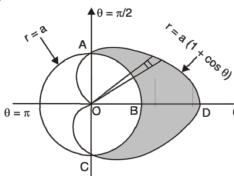




Which is the required area.
Example-4: Find the are lying inside a cardioid r = 1 + cosθ and outside the parabola r (1 + cosθ) = 1.
Sol. Let,
r = 1 + cosθ ……………………. (1)
r (1 + cosθ) = 1……………………. (2)
Solving these equations, we get
(1 + cosθ) (1 + cosθ) = 1
(1 + cosθ) ² = 1
1 + cosθ = 1
Cosθ = 0
θ = ±π / 2
So that, limits of r are,
1 + cosθ and 1 / 1 + cosθ
The area can be founded as below,
= 
= ½ 
= 
= 
= 
= 
= [ θ + θ/2 + sin 2θ/4 + 2 sin θ – ¼ (2 tan θ/2 + 2/3 tan3 θ/2)]π/20
= [π/2 + π/4 +0+ 2 sin π/2 – ½ tan π/4 – 1/6 tan3 π/4] = [3π/4 + 2 – ½ - 1/6 ] = [3π/4 + 4/3]
Double integrals as volumes
Suppose we have a curve y = f(x) is revolved about an axis, then a solid is generated, now we need to find out the volume of the solid generated,

The formula for volume of the solid generated about x-axis,

Example-1: Calculate the volume generated by the revolution of a cardioid,
r = a (1 – cosθ) about its axis
Sol. Here, r = a (1 – cosθ)
Volume =



=
= 2πa3/3 
Which is the volume of generated by cardioid.
Example-2: Find the volume generated by revolving a circle x ² + y² = 4 about the line x= 3.
Sol. We know that,
Volume = 
Here , PQ = 3 – x,
= 
= 2π 

= 2π  (3y – xy)+4-x2-4-x2
(3y – xy)+4-x2-4-x2
= 2π  [34-x2 - x4-x2 + 34-x2 - x4-x2]
[34-x2 - x4-x2 + 34-x2 - x4-x2]
= 4π[3 4 – x2 - x4 – x2] dx = 4π [ 3 x/2 4-x2 + 3 4/2 sin-1 x/2 + 1/3(4 – x2)3/2]2-2
= 4π[ 6 π/2+ 6π/2] = 24π2
The volume is 24π².
Example-3: Calculate the volume under the surface z = 3 + x² - 2y over the region R defined as 0≤ x ≤ 1 and -x ≤ y ≤ x
Sol. The is a double integral of z = 3 + x² - 2y over the region R
Volume will be,




References:
- E. Kreyszig, “Advanced Engineering Mathematics”, John Wiley & Sons, 2006.
- P. G. Hoel, S. C. Port And C. J. Stone, “Introduction To Probability Theory”, Universal Book Stall, 2003.
- S. Ross, “A First Course in Probability”, Pearson Education India, 2002.
- W. Feller, “An Introduction To Probability Theory and Its Applications”, Vol. 1, Wiley, 1968.
- N.P. Bali and M. Goyal, “A Text Book of Engineering Mathematics”, Laxmi Publications, 2010.